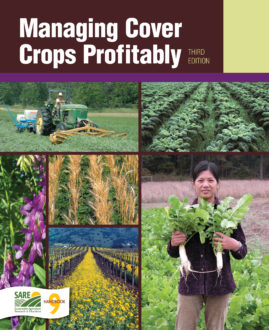Foreword
Cover crops slow erosion, improve soil, smother weeds, enhance nutrient and moisture availability, help control many pests and bring a host of other benefits to your farm. At the same time, they can reduce costs, increase profits and even create new sources of income. You’ll reap dividends on your cover crop investments for years, because their benefits accumulate over the long term.
Increasing energy costs will have a profound effect on farm economics in coming years. As we go to press, it is impossible to predict how fast energy costs will increase, but since cover crop economics are rooted in nitrogen dynamics (how much N you save or produce with cover crops), fuel costs (the cost of N and trips across the field) and commodity prices, energy prices will certainly impact the economics of cover crop use.
Economic comparisons in the 2nd edition were based on the old economy of two-dollar corn, twenty-cent nitrogen and cheap gas. Some studies showed that cover crops become more profitable as the price of nitrogen increases. We retained some of these excellent studies because data from new studies is not yet available. What we do know is that cover crops can help you to increase yields, save on nitrogen costs, reduce trips across the field and also reap many additional agronomic benefits.
There is a cover crop to fit just about every farming situation. The purpose of this book is to help you find which ones are right for you.
Farmers around the country are increasingly looking at the long-term contributions of cover crops to their whole farm system. Some of the most successful are those who have seen the benefits and are committed to making cover crops work for them. They are re-tooling their cropping systems to better fit cover crop growth patterns, rather than squeezing cover crops into their existing system, time permitting.
This 3rd edition of Managing Cover Crops Profitably aims to capture farmer and other research results from the past ten years. We verified the information from the 2nd edition, added new results and updated farmer profiles and research data throughout. We also added two new chapters.
Brassicas and Mustards lays out the current theory and management of cover crops in the BRASSICACEAE family. Brassica cover crops are thought to play a role in management of nematodes, weeds and disease by releasing chemical compounds from decomposing residue. Results are promising but inconsistent. Try brassicas on small plots and consult local expertise for additional information.
Managing Cover Crops in Conservation Tillage Systems addresses the management complexities of reduced tillage systems. If you are already using cover crops, the chapter will help you reduce tillage. If you are already using conservation tillage, it shows you how to add or better manage cover crops. Cover crops and conservation tillage team up to reduce energy use on your farm and that means more profits.
We have tried to include enough information for you to select and use cover crops appropriate to your operation. We recommend that you define your reasons for growing a cover crop—the section, Selecting the Best Cover Crops for Your Farm can help with this—and take as much care in selecting and managing cover crops as you would a cash crop.
Regional and site-specific factors can complicate cover crop management. No book can adequately address all the variables that make up a crop production system. Before planting a cover crop, learn as much as you can from this book and talk to others who are experienced with that cover crop.
We hope that this updated and expanded edition of Managing Cover Crops Profitably will lead to the successful use of cover crops on a wider scale as we continue to increase the sustainability of our farming systems.
Andy Clark, Communications Director
SARE Outreach
June 2007
